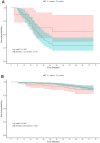Clinical significance of androgen receptor in unilateral invasive breast cancer in women
- PMID: 40846987
- PMCID: PMC12374384
- DOI: 10.1186/s40001-025-03072-7
Clinical significance of androgen receptor in unilateral invasive breast cancer in women
Abstract
Objective: To assess the prognostic relevance of androgen receptor (AR) expression in patients following modified radical surgery for invasive breast cancer.
Methods: A cohort of 515 patients who underwent modified radical mastectomy for breast cancer from July 2016 to November 2017 was analyzed. Immunohistochemistry was employed to determine the expression levels of AR, estrogen receptor (ER), progesterone receptor (PR), human epidermal growth factor receptor-2 (HER-2), cell proliferation nuclear antigen (Ki-67), oncogene (P-53), cytokeratin 5/6 (CK5/6), topoisomerase-2 (TOPO-2), and epidermal growth factor receptor (EGFR). The correlation between AR expression and clinicopathological features as well as prognosis was examined. Multifactorial analysis using Cox proportional risk regression identified independent prognostic factors for disease-free survival (DFS), and a nomogram model was developed based on these factors.
Results: Patients in the AR-positive group demonstrated a significantly higher frequency of low histologic grade (grade 1-2), ER positive, PR positive, TOPO-2-negative, CK5/6-negative, and EGFR-negative as compared to the AR-negative group (P < 0.05). Among ER( +)/HER-2(-) and ER( +)/HER-2( +) patients with breast cancer, AR-positive individuals exhibited prolonged DFS (P < 0.05). Conversely, in ER(-)/HER-2( +) and ER(-)/HER-2(-) patients with breast cancer, AR expression did not significantly influence disease-free survival (P > 0.05). Multifactorial regression analysis identified AR/ER ratio, histological classification, and lymph node metastasis as independent prognostic factors for DFS (all P < 0.05). The developed nomogram model underscored the significance of histological classification as the primary predictive factor for patient outcomes, followed by AR/ER ratio and lymph node metastasis CONCLUSION: AR expression holds varying prognostic implications across different breast cancer subtypes, with AR positivity indicating a favorable prognosis, particularly in ER-positive tumors.
Keywords: AR/ER; Androgen receptors; Breast cancer; Endocrine resistance; Prognosis.
© 2025. The Author(s).
Conflict of interest statement
Declarations. Ethics approval and consent to participate: This study was conducted in accordance with the Declaration of Helsinki and approved by the Ethics Committee of the Affiliated Hospital of Xuzhou Medical University (XYFY2022-KL321). Due to the retrospective nature of this study, with the approval of the Ethics Committee of Xuzhou Medical University Affiliated Hospital, we waived the requirement for written informed consent. Consent for publication: Not applicable. Competing interests: The authors declare no competing interests.
Figures












Similar articles
-
Androgen receptor expression and outcomes in early breast cancer: a systematic review and meta-analysis.J Natl Cancer Inst. 2014 Jan;106(1):djt319. doi: 10.1093/jnci/djt319. Epub 2013 Nov 22. J Natl Cancer Inst. 2014. PMID: 24273215
-
Androgen Receptor: Clinical Importance in Breast Cancer Patients Receiving CDK 4/6 Inhibitor Treatment.Medicina (Kaunas). 2025 Aug 14;61(8):1464. doi: 10.3390/medicina61081464. Medicina (Kaunas). 2025. PMID: 40870508 Free PMC article.
-
Sonographic Correlations With Histological Grade and Biomarker Profiles in Breast Invasive Ductal Carcinoma.Cancer Rep (Hoboken). 2025 Aug;8(8):e70288. doi: 10.1002/cnr2.70288. Cancer Rep (Hoboken). 2025. PMID: 40744681 Free PMC article.
-
Integrated proteomics and transcriptomics analysis reveals key regulatory genes between ER-positive/PR-positive and ER-positive/PR-negative breast cancer.BMC Cancer. 2025 Jul 1;25(1):1048. doi: 10.1186/s12885-025-14451-y. BMC Cancer. 2025. PMID: 40597935 Free PMC article.
-
Cost-effectiveness of using prognostic information to select women with breast cancer for adjuvant systemic therapy.Health Technol Assess. 2006 Sep;10(34):iii-iv, ix-xi, 1-204. doi: 10.3310/hta10340. Health Technol Assess. 2006. PMID: 16959170
References
-
- Itani N, Grogan N, Mott S, et al. Metastatic presentations of previously treated early-stage breast cancer patients and association with survival. Clin Breast Cancer. 2019;3(S1526–8209):30735–9. 10.1016/j.clbc.2019.11.004. - PubMed
MeSH terms
Substances
LinkOut - more resources
Full Text Sources
Medical
Research Materials
Miscellaneous

